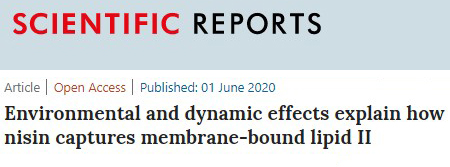Press-room / news / Science news /
Pyrophosphate pharmacophore model: How nisin captures lipid II
Researchers from the Group of in silico analysis of membrane proteins structure and the Laboratory of biomolecular modeling of IBCh RAS have predicted the structure of the complex between lantibiotic nisin with the bacterial cell wall precursor — lipid II — on the membrane surface.
Using molecular simulations it was demonstrated that the high selectivity of nisin/lipid II interaction is explained by the ability of lipid II’s pyrophosphate group to form a pharmacophore on the bilayer surface that cannot be formed by phospholipids: while adopting certain conformations the pyrophosphate’s oxygen atoms are situated at the unique distance on the membrane surface. It was shown that molecular recognition occurs via the induced-fit mechanism and is determined by the properties of the environment. Only one or two states within the conformational ensembles of both partners were found to be suitable for complex formation. These results may be employed for further development of new nisin-based antibiotics. The study is published in Scientific Reports.

june 1, 2020


